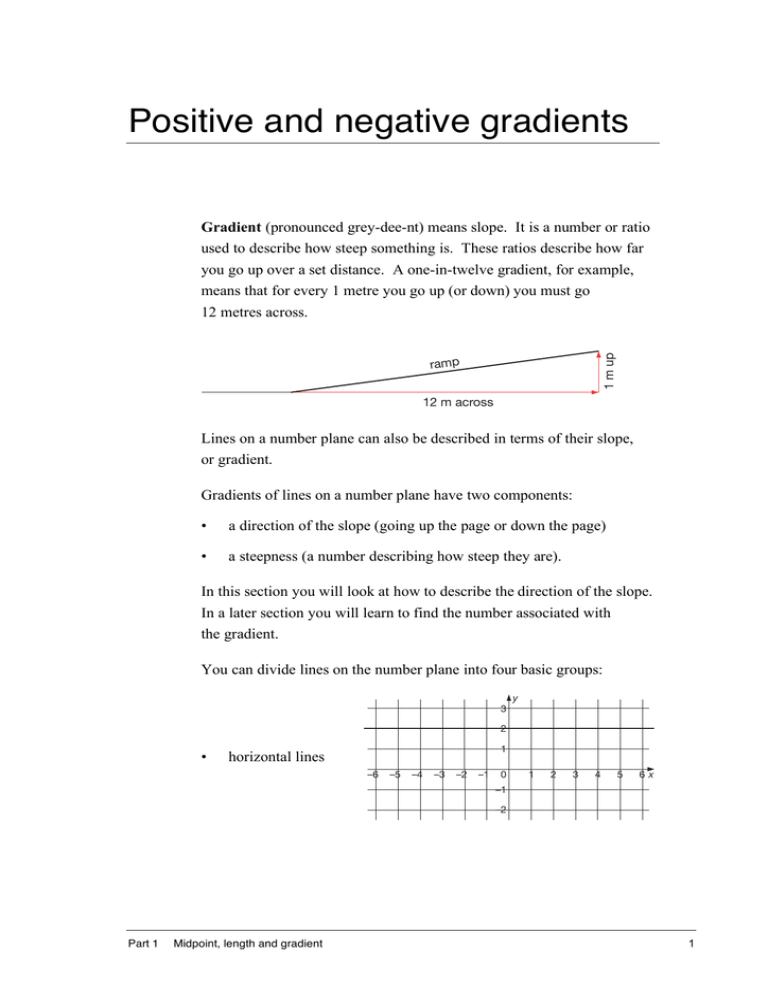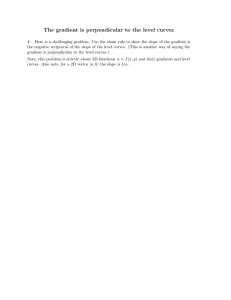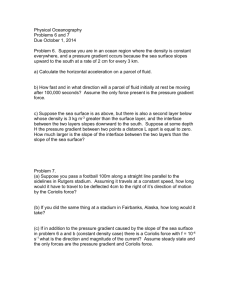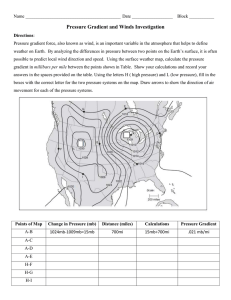Positive and negative gradients
advertisement

Positive and negative gradients 1 m up Gradient (pronounced grey-dee-nt) means slope. It is a number or ratio used to describe how steep something is. These ratios describe how far you go up over a set distance. A one-in-twelve gradient, for example, means that for every 1 metre you go up (or down) you must go 12 metres across. ramp 12 m across Lines on a number plane can also be described in terms of their slope, or gradient. Gradients of lines on a number plane have two components: • a direction of the slope (going up the page or down the page) • a steepness (a number describing how steep they are). In this section you will look at how to describe the direction of the slope. In a later section you will learn to find the number associated with the gradient. You can divide lines on the number plane into four basic groups: 3 y 2 • 1 horizontal lines –6 –5 –4 –3 –2 –1 0 1 2 3 4 5 6x –1 –2 Part 1 Midpoint, length and gradient 1 3 y 2 • 1 vertical lines –6 –5 –4 –3 –2 –1 0 1 2 3 4 5 6x 1 2 3 4 5 6x 1 2 3 4 5 6x –1 –2 3 • y 2 lines that slope down from left to right 1 –6 –5 –4 –3 –2 –1 0 –1 –2 3 y 2 • lines that slope up from left to right. 1 –6 –5 –4 –3 –2 –1 0 –1 –2 Lines that slope up are said to have a positive gradient, and lines that slope down are said to have a negative gradient. Vertical and horizontal lines will be discussed in a later part. A class was given the following task. Describe the slope of the lines on this graph. A y 3 D 2 C 1 –6 –5 –4 –3 –2 –1 0 1 2 3 4 5 6x –1 B 2 –2 PAS5.1.2 Coordinate geometry Two students gave the following answers. Line AB goes down the graph from left to right so it must have a negative gradient. Oh, and it’s really steep. Line CD goes up the graph so I think that means it has a positive gradient. And you can see that it is almost flat so it is not very steep at all. Lauren was confused and asked the following question. But if you go from D to C you are going down the page. Doesn’t down mean a negative slope? The teacher explained that when reading a graph you go from left to right just like you do with words. So you have to move from C to D and therefore you go up the page. You have to start at this side of the line. A y 3 D 2 C 1 –6 –5 –4 –3 –2 –1 0 1 2 3 4 5 6x –1 B –2 left to right Now it is your turn to make decisions about the gradients of lines on the number plane. Part 1 Midpoint, length and gradient 3 Activity – Positive and negative gradients Try these. 1 Use the graph below to complete these tasks. E 6 D y B 5 4 K 3 J 2 F 1 –6 –5 –4 –3 –2 –1 0 1 2 3 4 5 6x –1 G –2 H –3 –4 –5 –6 A a C Use the letters to name all the lines that have a positive gradient. ___________________________________________________ 4 b Name the steepest line. ________________________________ c True or false: EF is drawn near the top of the graph so it has a positive gradient. _____________________________________ PAS5.1.2 Coordinate geometry 2 A line MN is not very steep and has a negative gradient. Draw a line MN on the grid below that fits this information. 6 y 5 4 3 2 1 –3 –2 –1 0 1 2 3 4 5 6x –1 –2 Check your response by going to the suggested answers section. Part 1 Midpoint, length and gradient 5 Activity – Positive and negative gradients 1 2 a AB, CD and JK. b CD c False (EF goes down the graph so it has a negative slope.) There are an infinite number of correct answers. You should have used a ruler to drawn a line that goes down the graph from left to right. It should have been fairly flat. It could have been at the top of the graph, in the middle, or at the bottom. Some correct answers are shown below. You only needed to draw one line. Did you remember to label your line with M and N? M 6 y N 5 4 M 3 N 2 M 1 M –3 –2 –1 0 –1 –2 6 1 2 3 4 5 6 xN N PAS5.1.2 Coordinate geometry




